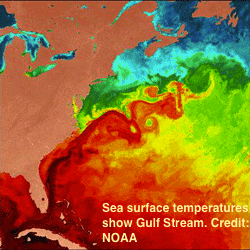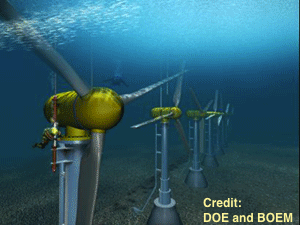by Ellen Klicka, AMS Policy Program
Very exciting developments are about to unfold at the Southeast National Marine Renewable Energy Center (SNMREC) at Florida Atlantic University: Ocean current energy developments.
 At this week’s AMS Washington Forum, Dr. Camille Coley, Associate Director at SNMREC, will discuss the process her center is pioneering to get the nascent marine hydrokinetic industry off the ground and into the water, so to speak. Coley’s remarks are expected to touch on the realms of technology commercialization, environmental impacts, the federal regulation landscape, public-private partnerships, and the national energy agenda.
At this week’s AMS Washington Forum, Dr. Camille Coley, Associate Director at SNMREC, will discuss the process her center is pioneering to get the nascent marine hydrokinetic industry off the ground and into the water, so to speak. Coley’s remarks are expected to touch on the realms of technology commercialization, environmental impacts, the federal regulation landscape, public-private partnerships, and the national energy agenda.
Leaders from the weather, water and climate enterprise are gathering for three days in Washington, DC, as they do every April, to discuss pressing issues, identify business opportunities and forge stronger relationships with federal policy makers. Due to the challenges marine hydrokinetics faces, the field serves as an informative microcosm of the multidisciplinary, multi-sector issues the AMS community shares. Such multifaceted explorations are typical of Washington Forum sessions.
Coley says harnessing offshore renewable energy sources could improve U.S. energy security. The oil price spike of the mid-2000s revived the U.S. Department of Energy’s original 1970s interest in what was then a fringe area of science involving the conversion of kinetic energy from ocean waves, tides and currents.
Resource assessments showed Southeastern Florida as a potential goldmine of ocean current resources, and the SNMREC was born in 2007. Wave and tidal energy technologies have seen a slightly clearer path from research to deployment because the action occurs near the shore in waters regulated at the state level, where establishing procedures can be a more nimble process than at the federal level. Currents strong enough to generate energy are found on the Outer Continental Shelf at least 12 miles offshore, in federal waters.
Nearly five years ago, SNMREC began working with the Minerals Management Service, now called the Bureau of Ocean Energy Management (BOEM), to obtain the first lease ever to be granted to install turbines on the Outer Continental Shelf. Both SNMREC and BOEM charted new territory as they took each step. In addition to applying for the permit under an interim policy set in 2007, BOEM conducted an environmental assessment and ensure compliance. The assessment surveyed areas of planned development for possible negative impacts on sea turtle, manatee, shark, deep water coral and other marine species populations. The Navy, NOAA, U.S. Army Corps of Engineers and EPA all weighed in. Sensors and cameras have been installed to monitor the condition of the turbines and observe any approaching marine life.
The center expects the final green light this month and hopes to have pilot turbines in the water this year.
Coley notes lessons learned for future applicants seeking a BOEM license. Even with funding boosts from the American Recovery and Reinvestment Act of 2009, tight federal budgets have created challenges for public investment in research, development, pilot deployment and environmental impact checks. Private ocean current energy developers can’t obtain venture capital until the technology is proven. According to the Department of Energy’s Technology Readiness Level scale, which measures the maturity of technologies for application, ocean current energy scores a 4 on the scale from 1-9. Private financiers generally consider investing in technologies at level 8. Where will the money come from to drive ocean current energy up four more points? It’s the classic chicken and egg dilemma that could strand this emerging industry in the “valley of death” unless policy makers intervene.
According to Coley, a federal renewable energy standard, combined with loans or tax credits for marine hydrokinetic energy development, would create demand and a secure market for additional renewable energy capacity.
The credits could be analogous to the production and investment tax credits already established for wind power. Incidentally, the Senate Finance Committee is aiming for this week to begin its consideration of how and whether to extend a bevy of temporary tax breaks that lapsed at the beginning of this year, such as the wind production tax credit (PTC) and other clean energy incentives. To date, no federal incentive bills have been introduced to encourage development and commercialization of marine hydrokinetics.
Coley also recommends a reevaluation of the regulatory process to assist timely project development and ensure appropriate attention to environmental and community safeguards. She says future ocean current permit applicants would benefit from increased collaboration among public and private entities, including the electricity industry, research engineers, aquatic scientists, environmentalists and community stakeholders.
Coley will participate in the Washington Forum’s Water-Energy Nexus panel Thursday, April 3 from 10:30 am – 12:00 pm. Can’t make it to DC? Follow the conversation with the hashtag #AMSWF or join the AMS Washington Forum LinkedIn group.